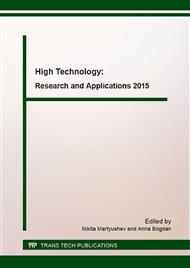[1]
M.A. El Hajj Hassan and M.M. El Jamal. Kinetic Study of the Electrochemical oxidation of methylene blue with Pt Electrode, Portugaliae Electrochimica Acta. 30 (2012) 351-359.
DOI: 10.4152/pea.201205351
Google Scholar
[2]
G.L. Lobanov, L.N. Shiyan, T.A. Yurmazova, D.A. Vojno. Investigation of the mechanism of reactions occurring in to electro exposed to aqueous solutions of organic substances, Modern problems of science and education. 6 (2013).
Google Scholar
[3]
G.L. Lobanov, L.N. Shiyan, T.A. Yurmazova, A.I. Galanov. Investigation of the process of electro effects on iron and aluminum granules with solutions of organic substances, Proceedings of the universities. Physics. 57 (2014) 141-145.
Google Scholar
[4]
I.M. Piskarev, G.M. Spiro, V.D. Selemir, V.I. Karelin, S.I. Shlepkin. Dependence on temreratury rate of formation of the active particles in nanosecond streamer corona electric discharge between the electrode and the solid surface. High Energy Chemistry. 41 (2007).
DOI: 10.1134/s0018143907040133
Google Scholar
[5]
I.M. Piskarev. Model reactions in the corona in the O2 (g) - H2O. Journal of Physical Chemistry. 74 (2000) 546-551.
Google Scholar
[6]
A.I. Maximov, A.V. Hlyustova, I.N. Subbotkina. Study destruction of dyes methylene blue aqueous solution under the action of glow discharge and difragmetnogo, Proceedings of the higher educational institutions. Chemistry and Chemical Engineering. 52 (2009).
Google Scholar
[7]
A. I. Maksimov, I. N. Subbotkina. The effect of a diaphragm discharge and ozone on an active bright-red dye 6C solution, Surface Engineering and Applied Electrochemistry. 49 (2013) 235-240.
DOI: 10.3103/s1068375513030101
Google Scholar
[8]
A.G. Zherlitsyn, K.S. Lazar, V.P. Shiyan, Produce methane-hydrogen mixture of hydrocarbon gas in the microwave plasma discharge, Proceedings of Higher Education Institutions. Physics. 57 (2014) 136-139.
Google Scholar
[9]
V.A. Orlov. Water ozonation, Stroyizdat, Moscow, (1984).
Google Scholar


